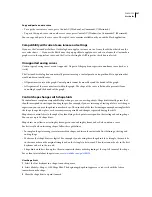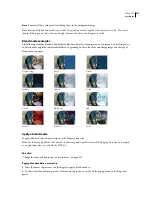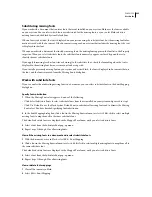
FLASH CS3
User Guide
261
High quality anti-aliasing is automatically enabled whenever you publish to Flash Player 8 or later, and Anti-Alias
For Readability or Custom Anti-Alias is selected. Anti-Alias For Readability may cause a slight delay when you load
Flash SWF files, especially if you are using four or five different character sets in the first frame of a Flash document.
High quality anti-aliasing may also increase Flash Player’s memory usage. Using four or five fonts, for example, can
increase memory usage by approximately 4 MB.
When the publish setting of your file is Adobe® Flash® Player 8 or later, and Anti-Alias For Readability or Custom
Anti-Alias is your chosen anti-aliasing option, high-quality anti-aliasing applies to the following:
•
Untransformed text that is scaled and rotated
Note:
Although the text can be scaled or rotated, it must remain flat (that is, untransformed). For example, if you skew
the fonts or otherwise manipulate the font shapes, Anti-Alias for Readability is automatically disabled.
•
All font families (including bold, italic, and so on)
•
Display sizes of up to 255 points
•
Exporting to most non-Flash file formats (GIF or JPEG)
High quality anti-aliasing is disabled under the following conditions:
•
Flash Player 7 or earlier is the selected version of Flash Player.
•
An anti-aliasing option other than Anti-Alias for Readability or Custom Anti-Alias is selected.
•
Text is skewed or flipped.
•
The FLA file is exported to a PNG file.
Unicode text encoding in Flash applications
Macromedia Flash Player 7 from Adobe and later supports Unicode text encoding for SWF files in Flash Player
format. This support greatly enhances your ability to use multilanguage text in your SWF files, such as two languages
within a single text field. Any user with Flash Player 7 or later can view multilanguage text in a Flash Player 7 or later
application, regardless of the language used by the operating system running the player.
See also
“Creating multilanguage text” on page 275
Font outlines and device fonts
When you publish or export a Flash document, fonts in text fields are represented by embedded font outlines or by
font names. Alternatively, you can use device fonts to specify a general type of font, such as sans serif.
Font outlines and names
For static text, Flash creates outlines of the font and embeds them in the SWF file. Flash Player then uses the outlines
to display the text.
For dynamic or input text, Flash stores the font names; Flash Player then locates identical or similar fonts on the
user’s system when the Flash application is displayed. To ensure that users have the correct fonts for dynamic or input
text, you can embed font outlines, but this can increase file size.
Not all fonts displayed in Flash can be exported as outlines with a Flash application. To verify that a font can be
exported, use the View
> Preview Mode > Antialias Text command to preview the text; jagged type indicates that
Flash does not recognize that font’s outline and will not export the text.
















































